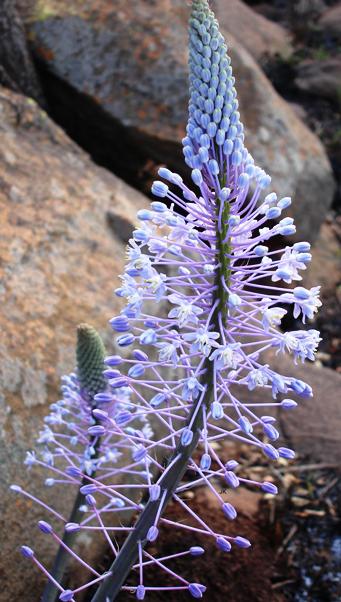|
Botanical name |
Merwilla plumbea |
|
Other names |
Wild squill; blouslangkop (Afrikaans); inguduza (Zulu); Scilla natalensis |
|
Family |
Hyacinthaceae |
|
Dimensions |
Erect growing bulbous perennial |
|
Description of stem |
Flowering stem curves mildly, earning the Afrikaans name referring to a snake |
|
Description of leaves |
About seven straight, smooth green, broad, but tapering and pointed leaves of 40 cm in length form a rosette around the inflorescence that appears before the leaves in spring; the leaves turn yellow and die off in autumn |
|
Description of flowers |
About a meter high (but variable in height); raceme with many small light blue, violet blue or blue and white flowers appearing in spring; floral parts in sixes; stalks of the individual flowers coloured as the petals; white filaments |
|
Description of seed/fruit |
Wrinkled seeds released by from a dehiscent capsule |
|
Description of roots |
Bulb 10 to 15 cm in diameter; over half of the bulb positioned above ground level; cartilaginous tunic around the bulb |
|
Variation |
Bulb size, flower and leaf colour; blue or mauve flowers |
|
|
|
|
Propagation and cultivation |
Transplants easily, also offset bulbs (forming readily around well-growing mature bulbs) or seed can be planted; requires well-drained soil; takes about three years to bloom |
|
Tolerances |
Needs shelter from frost in cold climates |
|
Uses |
To make medicine for female infertility and male impotency; also used in the treatment of skin conditions; ash from the burnt plant has been used on open sores garden plant in clumps on rockeries, also a good container plant; soap making |
|
Ecological rarity |
Probably threatened by its popularity in the indigenous medicine trade |
|
Pests and diseases |
|
|
Other |
|
|
Location |
In rocky grassland |
|
Distribution (SA provinces) |
Mpumalanga, Free State, KwaZulu-Natal (common in the Drakensberg) and Eastern Cape |
|
Country |
South Africa, Lesotho, Swaziland |



